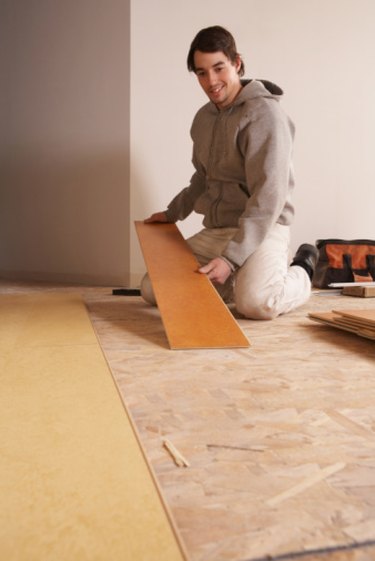
Laminate floors aren't the same as nail-down hardwood floors. The boards fit together like pieces in a puzzle and when the entire floor is assembled, it floats over the subfloor like a film coating. If it's uneven, it may be because the subfloor is bumpy or that it fits too tightly and bubbles are forming as the edges press against the wall. It may also be the result of moisture. Most repair strategies involve disassembly.
Importance of Leveling the Subfloor
Video of the Day
If you lay a laminate floor on a concrete or plywood subfloor that hasn't been leveled, you might even find it hard to snap the boards together. If bumps occur under a joint, they push of on the edges of the board and angle them away from each other, opening a gap and making it harder to mate them. This principle continues to apply even after you have successfully joined them. The floor may appear level, but when you walk on it, your weight pushes down on the boards, which pivot on the high point and either separate or break.
Video of the Day
Repair Strategy
There is really only one way to correct a subfloor that isn't level, and that is to spread leveling compound in the low spots and sand or chisel down the high ones. Unfortunately, this means that if you've already installed the floor, you have to remove it. It isn't as hard a job as it sounds. Clear out all the furniture and remove the baseboards, then begin disassembling at the wall by lifting the outside edges of the boards and pulling them apart. You don't always have to remove the whole floor--just the part that's uneven.
Tight-Fitting Floor
When you install a laminate floor, you should leave a 1/4-inch gap between the edges of the floor and the walls to account for expansion. When you don't, the boards may press against the wall, and because they have nowhere else to go, begin to lift off the floor. Like leveling the subfloor, trimming the edges of the laminate floor requires some disassembly. You may be able to remedy the situation by removing one course of boards along the wall and trimming them, but if not, you'll have to remove them back to the opposite wall and trim the last course and the ends as well.
Moisture
Laminate boards are made with a mixture of wood fibers and plastic, and the wood tends to absorb moisture and swell. When this happens, the edges of the boards expand, press against each other and start to buckle. This is a serious problem because it usually means the boards are damaged and need to be replaced. Installers avoid it by laying a moisture barrier between the laminate and the subfloor. When you remove the floor boards and replace them, be sure to cover the subfloor with a layer of plastic or tarpaper so it doesn't happen again.